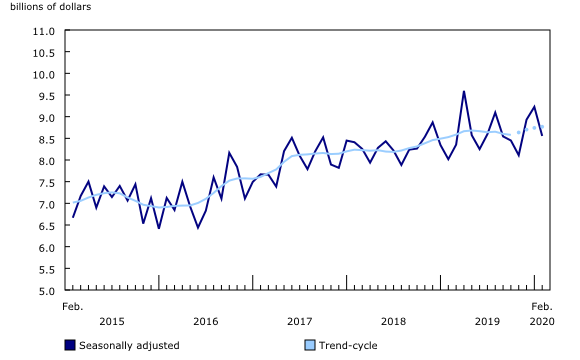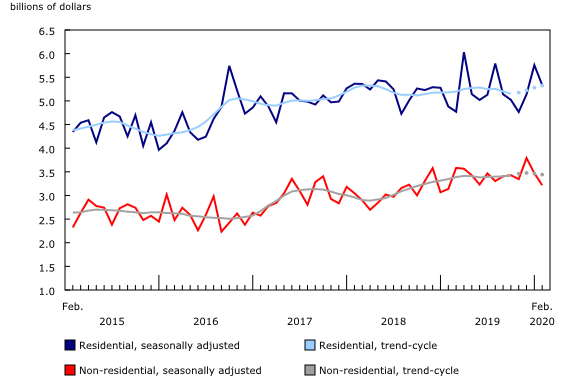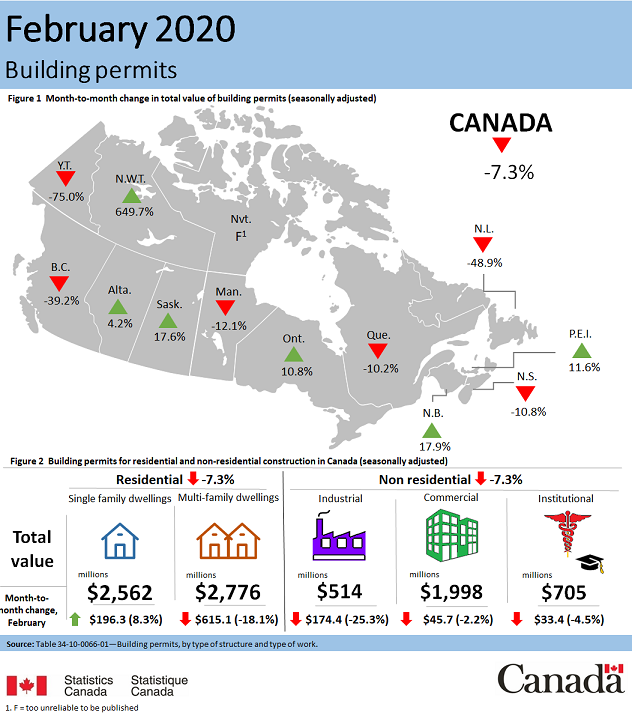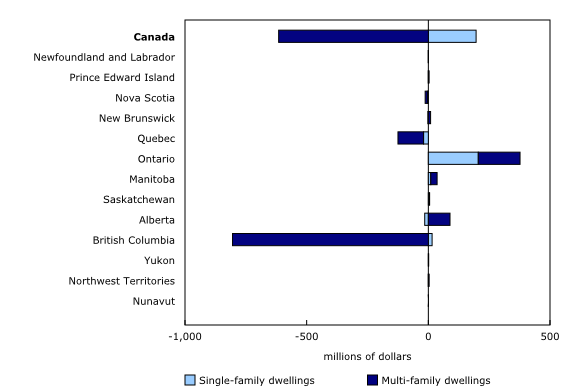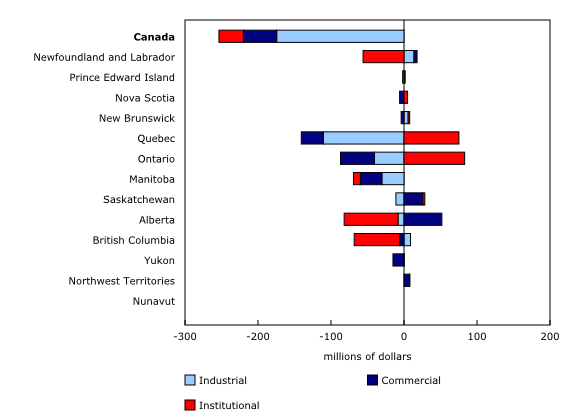Building permits, February 2020
Archived Content
Information identified as archived is provided for reference, research or recordkeeping purposes. It is not subject to the Government of Canada Web Standards and has not been altered or updated since it was archived. Please "contact us" to request a format other than those available.
Released: 2020-04-08
$8.6 billion
February 2020
-7.3% 
(monthly change)
$39.3 million
February 2020
-48.9% 
(monthly change)
$25.3 million
February 2020
11.6% 
(monthly change)
$116.6 million
February 2020
-10.8% 
(monthly change)
$76.1 million
February 2020
17.9% 
(monthly change)
$1,668.3 million
February 2020
-10.2% 
(monthly change)
$3,812.2 million
February 2020
10.8% 
(monthly change)
$241.5 million
February 2020
-12.1% 
(monthly change)
$151.3 million
February 2020
17.6% 
(monthly change)
$1,089.2 million
February 2020
4.2% 
(monthly change)
$1,317.3 million
February 2020
-39.2% 
(monthly change)
$4.5 million
February 2020
-75.0% 
(monthly change)
$13.0 million
February 2020
649.7% 
(monthly change)
F
February 2020
F
(monthly change)
The total value of building permits issued by Canadian municipalities decreased 7.3% to $8.6 billion in February, driven by the residential component. Declines were reported in five provinces, with the largest decrease reported in British Columbia (-39.2% to $1.3 billion). Meanwhile, Alberta reported the fourth consecutive monthly growth, up 4.2% to $1.1 billion.
In the context of the rapidly-evolving situation around the novel coronavirus (also known as COVID-19), Statistics Canada remains committed to providing timely information to all Canadians. As such, the agency has released March 2020 preliminary flash estimates of building permits for select regions.
For more information on housing, please visit the Housing Statistics Portal.
Single-family permits post largest growth since October 2016
The total value of residential permits decreased 7.3% to $5.3 billion, mostly due to a significant decline in permits for multi-family dwellings. Permits for multi-family dwellings were down 18.1% to $2.8 billion, with the largest decrease originating in the census metropolitan area (CMA) of Vancouver (-$841 million). The decrease in Vancouver was mainly due to an increased number of permits being issued in January to preempt an increase in local development fees. Excluding the CMA of Vancouver, the value of permits for multi-family dwellings rose 10.3% on a national level in February.
The total value of permits for single-family dwellings increased 8.3% to $2.6 billion. These gains were driven by housing developments in Ontario (+$205 million), bringing the value of permits in the province to its highest level since December 2017.
Value of industrial permits down
In February, the value of non-residential permits was down 7.3% to $3.2 billion. This decrease was largely due to declines in the value of industrial permits (-25.3% to $514 million), mainly in the province of Quebec.
The value of institutional permits declined 4.5% to $705 million. This was largely due to decreases in Alberta (-$74 million) and British Columbia (-$62 million), following strong gains in those provinces in January.
Total value of commercial permits was down 2.2% to $2.0 billion, with declines reported in six provinces.
Note to readers
Unless otherwise stated, this release presents seasonally adjusted data, which facilitate month-to-month comparisons by removing the effects of seasonal variations. For information on seasonal adjustment, see Seasonally adjusted data – Frequently asked questions.
The Building Permits Survey covers over 2,400 municipalities, representing 95% of the Canadian population. The communities representing the other 5% of the population are very small, and their levels of building activity have little impact on the total for the entire population.
Building permit data are used as a leading indicator of activity in the construction industry.
The value of planned construction activities presented in this release excludes engineering projects (such as waterworks, sewers or culverts) and land.
For the purposes of this release, the census metropolitan area of Ottawa–Gatineau (Ontario and Quebec) is divided into two areas: the Ottawa part and the Gatineau part.
Unless otherwise specified, the highlights refer to seasonally adjusted current dollars and are ranked in terms of dollar change rather than percentage change.
Building components
Single-family dwellings: Residential buildings containing only one dwelling unit (for example, single-detached house, bungalow, linked home [linked at the foundation]).
Multi-family dwellings: Residential buildings containing multiple dwelling units (for example, apartment, apartment condominium, row house, semi-detached).
Industrial buildings: Buildings used in the processing or production of goods, or related to transportation and communication.
Commercial buildings: Buildings used in the trade or distribution of goods and services.
Institutional and government buildings: Buildings used to house public and semi-public services, such as those related to health and welfare, education, or public administration, as well as buildings used for religious services.
Revision
Unadjusted data for the current reference month are subject to revision based on late responses. As per standard Statistics Canada practices, unadjusted data for the previous year have been revised. Seasonally adjusted data have also been revised for the previous three years.
Trend-cycle estimates have been added to the charts as a complement to the seasonally adjusted series. Both seasonally adjusted data and trend-cycle estimates are subject to revision as additional observations become available. These revisions could be large and could even lead to a reversal of movement, especially at the end of the series. The higher variability associated with trend-cycle estimates is indicated with a dotted line on the chart.
For information on trend-cycle data, see the StatCan Blog and Trend-cycle estimates – Frequently asked questions.
Next release
Data on building permits for March will be released on May 8.
Contact information
For more information, or to enquire about the concepts, methods or data quality of this release, contact us (toll-free 1-800-263-1136; 514-283-8300; STATCAN.infostats-infostats.STATCAN@canada.ca) or Media Relations (613-951-4636; STATCAN.mediahotline-ligneinfomedias.STATCAN@canada.ca).
- Date modified:


